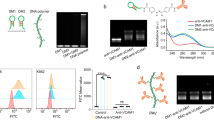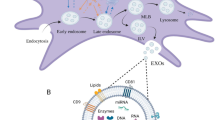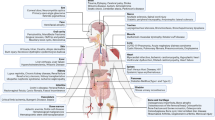Abstract
Targeting the delivery of therapeutics specifically to diseased tissue enhances their efficacy and decreases their side effects. Here we show that mesenchymal stromal cells with their nuclei removed by density-gradient centrifugation following the genetic modification of the cells for their display of chemoattractant receptors and endothelial-cell-binding molecules are effective vehicles for the targeted delivery of therapeutics. The enucleated cells neither proliferate nor permanently engraft in the host, yet retain the organelles for energy and protein production, undergo integrin-regulated adhesion to inflamed endothelial cells, and actively home to chemokine gradients established by diseased tissues. In mouse models of acute inflammation and of pancreatitis, systemically administered enucleated cells expressing two types of chemokine receptor and an endothelial adhesion molecule enhanced the delivery of an anti-inflammatory cytokine to diseased tissue (with respect to unmodified stromal cells and to exosomes derived from bone-marrow-derived stromal cells), attenuating inflammation and ameliorating disease pathology. Enucleated cells retain most of the cells’ functionality, yet acquire the cargo-carrying characteristics of cell-free delivery systems, and hence represent a versatile delivery vehicle and therapeutic system.
This is a preview of subscription content, access via your institution
Access options
Access Nature and 54 other Nature Portfolio journals
Get Nature+, our best-value online-access subscription
$29.99 / 30 days
cancel any time
Subscribe to this journal
Receive 12 digital issues and online access to articles
$99.00 per year
only $8.25 per issue
Buy this article
- Purchase on Springer Link
- Instant access to full article PDF
Prices may be subject to local taxes which are calculated during checkout






Similar content being viewed by others
Data availability
The main data supporting the results in this study are available within the paper and its Supplementary Information. The raw and analysed datasets generated during the study are too large to be publicly shared, but they are available for research purposes from the corresponding author on reasonable request. Source data are provided with this paper.
References
Allen, T. M. & Cullis, P. R. Drug delivery systems: entering the mainstream. Science 303, 1818–1822 (2004).
Yoo, J. W., Irvine, D. J., Discher, D. E. & Mitragotri, S. Bio-inspired, bioengineered and biomimetic drug delivery carriers. Nat. Rev. Drug Discov. 10, 521–535 (2011).
Lyerly, H. K., Osada, T. & Hartman, Z. C. Right time and place for IL12: targeted delivery stimulates immune therapy. Clin. Cancer Res. 25, 9–11 (2019).
Fioranelli, M. & Roccia, M. G. Twenty-five years of studies and trials for the therapeutic application of IL-10 immunomodulating properties. From high doses administration to low dose medicine new paradigm. J. Integr. Cardiol. 1, 2–6 (2014).
Samanta, S. et al. Exosomes: new molecular targets of diseases. Acta Pharmacol. Sin. 39, 501–513 (2018).
Han, X., Wang, C. & Liu, Z. Red blood cells as smart delivery systems. Bioconjugate Chem. 29, 852–860 (2018).
Fang, R. H., Kroll, A. V., Gao, W. & Zhang, L. Cell membrane coating nanotechnology. Adv. Mater. 30, e1706759 (2018).
Thanuja, M. Y., Anupama, C. & Ranganath, S. H. Bioengineered cellular and cell membrane-derived vehicles for actively targeted drug delivery: so near and yet so far. Adv. Drug Deliv. Rev. 132, 57–80 (2018).
Labusca, L., Herea, D. D. & Mashayekhi, K. Stem cells as delivery vehicles for regenerative medicine-challenges and perspectives. World J. Stem Cells 10, 43–56 (2018).
Sackstein, R. The lymphocyte homing receptors: gatekeepers of the multistep paradigm. Curr. Opin. Hematol. 12, 444–450 (2005).
Nitzsche, F. et al. Concise review: MSC adhesion cascade–insights into homing and transendothelial migration. Stem Cells 35, 1446–1460 (2017).
Ullah, M., Liu, D. D. & Thakor, A. S. Mesenchymal stromal cell homing: mechanisms and strategies for improvement. iScience 15, 421–438 (2019).
Fischer, U. M. et al. Pulmonary passage is a major obstacle for intravenous stem cell delivery: the pulmonary first-pass effect. Stem Cells Dev. 18, 683–692 (2009).
Karp, J. M. & Leng Teo, G. S. Mesenchymal stem cell homing: the devil is in the details. Cell Stem Cell 4, 206–216 (2009).
Galipeau, J. & Sensebe, L. Mesenchymal stromal cells: clinical challenges and therapeutic opportunities. Cell Stem Cell 22, 824–833 (2018).
Marks, P. W., Witten, C. M. & Califf, R. M. Clarifying stem-cell therapy’s benefits and risks. N. Engl. J. Med. 376, 1007–1009 (2017).
Wigler, M. H. & Weinstein, I. B. A preparative method for obtaining enucleated mammalian cells. Biochem. Biophys. Res. Commun. 63, 669–674 (1975).
Shay, J. W. Cell enucleation, cybrids, reconstituted cells, and nuclear hybrids. Methods Enzymol. 151, 221–237 (1987).
Coimbra, V. C. et al. Enucleated L929 cells support invasion, differentiation, and multiplication of Trypanosoma cruzi parasites. Infect. Immun. 75, 3700–3706 (2007).
Graham, D. M. et al. Enucleated cells reveal differential roles of the nucleus in cell migration, polarity, and mechanotransduction. J. Cell Biol. 217, 895–914 (2018).
Wolbank, S. et al. Telomerase immortalized human amnion- and adipose-derived mesenchymal stem cells: maintenance of differentiation and immunomodulatory characteristics. Tissue Eng. Part A 15, 1843–1854 (2009).
Malawista, S. E., Van Blaricom, G. & Breitenstein, M. G. Cryopreservable neutrophil surrogates. Stored cytoplasts from human polymorphonuclear leukocytes retain chemotactic, phagocytic, and microbicidal function. J. Clin. Invest. 83, 728–732 (1989).
Keys, J., Windsor, A. & Lammerding, J. Assembly and use of a microfluidic device to study cell migration in confined environments. Methods Mol. Biol. 1840, 101–118 (2018).
Lammerding, J. Mechanics of the nucleus. Compr. Physiol. 1, 783–807 (2011).
Guilak, F., Tedrow, J. R. & Burgkart, R. Viscoelastic properties of the cell nucleus. Biochem. Biophys. Res. Commun. 269, 781–786 (2000).
Stewart-Hutchinson, P. J., Hale, C. M., Wirtz, D. & Hodzic, D. Structural requirements for the assembly of LINC complexes and their function in cellular mechanical stiffness. Exp. Cell. Res. 314, 1892–1905 (2008).
Caille, N., Thoumine, O., Tardy, Y. & Meister, J. J. Contribution of the nucleus to the mechanical properties of endothelial cells. J. Biomech. 35, 177–187 (2002).
Marquez-Curtis, L. A. & Janowska-Wieczorek, A. Enhancing the migration ability of mesenchymal stromal cells by targeting the SDF-1/CXCR4 axis. BioMed. Res. Int. 2013, 561098 (2013).
Pandolfi, F. et al. Integrins: integrating the biology and therapy of cell–cell interactions. Clin. Ther. 39, 2420–2436 (2017).
Chigaev, A. et al. Real time analysis of the affinity regulation of alpha 4-integrin. The physiologically activated receptor is intermediate in affinity between resting and Mn(2+) or antibody activation. J. Biol. Chem. 276, 48670–48678 (2001).
Boltze, J. et al. The dark side of the force – constraints and complications of cell therapies for stroke. Front. Neurol. 6, 155 (2015).
Jung, J. W. et al. Familial occurrence of pulmonary embolism after intravenous, adipose tissue-derived stem cell therapy. Yonsei Med. J. 54, 1293–1296 (2013).
Bartosh, T. J. et al. Aggregation of human mesenchymal stromal cells (MSCs) into 3D spheroids enhances their antiinflammatory properties. Proc. Natl Acad. Sci. USA 107, 13724–13729 (2010).
Levy, O. et al. mRNA-engineered mesenchymal stem cells for targeted delivery of interleukin-10 to sites of inflammation. Blood 122, e23–e32 (2013).
Gordon, S. et al. Antigen markers of macrophage differentiation in murine tissues. Curr. Top. Microbiol. Immunol. 181, 1–37 (1992).
Devine, M. J., Mierisch, C. M., Jang, E., Anderson, P. C. & Balian, G. Transplanted bone marrow cells localize to fracture callus in a mouse model. J. Orthop. Res. 20, 1232–1239 (2002).
Ignowski, J. M. & Schaffer, D. V. Kinetic analysis and modeling of firefly luciferase as a quantitative reporter gene in live mammalian cells. Biotechnol. Bioeng. 86, 827–834 (2004).
Alvarez, H. M. et al. Effects of PEGylation and immune complex formation on the pharmacokinetics and biodistribution of recombinant interleukin 10 in mice. Drug Metab. Dispos. 40, 360–373 (2012).
Greenberg, J. A. et al. Clinical practice guideline: management of acute pancreatitis. Can. J. Surg. 59, 128–140 (2016).
Forsmark, C. E., Vege, S. S. & Wilcox, C. M. Acute Pancreatitis. N. Engl. J. Med. 375, 1972–1981 (2016).
Niederau, C., Ferrell, L. D. & Grendell, J. H. Caerulein-induced acute necrotizing pancreatitis in mice: protective effects of proglumide, benzotript, and secretin. Gastroenterology 88, 1192–1204 (1985).
Su, K. H., Cuthbertson, C. & Christophi, C. Review of experimental animal models of acute pancreatitis. HPB 8, 264–286 (2006).
Rongione, A. J. et al. Interleukin 10 reduces the severity of acute pancreatitis in rats. Gastroenterology 112, 960–967 (1997).
van Laethem, J. L. et al. Interleukin 10 prevents necrosis in murine experimental acute pancreatitis. Gastroenterology 108, 1917–1922 (1995).
Fedorak, R. N. et al. Recombinant human interleukin 10 in the treatment of patients with mild to moderately active Crohn’s disease. The Interleukin 10 Inflammatory Bowel Disease Cooperative Study Group. Gastroenterology 119, 1473–1482 (2000).
Nowakowski, A., Andrzejewska, A., Janowski, M., Walczak, P. & Lukomska, B. Genetic engineering of stem cells for enhanced therapy. Acta Neurobiol. Exp. 73, 1–18 (2013).
Cui, L. L. et al. The cerebral embolism evoked by intra-arterial delivery of allogeneic bone marrow mesenchymal stem cells in rats is related to cell dose and infusion velocity. Stem Cell Res. Ther. 6, 11 (2015).
Krueger, T. E. G., Thorek, D. L. J., Denmeade, S. R., Isaacs, J. T. & Brennen, W. N. Concise review: mesenchymal stem cell-based drug delivery: the good, the bad, the ugly, and the promise. Stem Cells Transl. Med. 7, 651–663 (2018).
Yin, J. Q., Zhu, J. & Ankrum, J. A. Manufacturing of primed mesenchymal stromal cells for therapy. Nat. Biomed. Eng. 3, 90–104 (2019).
Ungerechts, G. et al. Moving oncolytic viruses into the clinic: clinical-grade production, purification, and characterization of diverse oncolytic viruses. Mol. Ther. Methods Clin. Dev. 3, 16018 (2016).
Chen, H., Marino, S. & Ho, C. Y. 97. Large scale purification of AAV with continuous flow ultracentrifugation. Mol. Ther. 24, S42 (2016).
Vazquez-Lombardi, R., Roome, B. & Christ, D. Molecular engineering of therapeutic cytokines. Antibodies 2, 426–451 (2013).
Wigler, M. H., Neugut, A. I. & Weinstein, I. B. Enucleation of mammalian cells in suspension. Methods Cell. Biol. 14, 87–93 (1976).
Bartosh, T. J. & Ylostalo, J. H. Preparation of anti-inflammatory mesenchymal stem/precursor cells (MSCs) through sphere formation using hanging-drop culture technique. Curr. Protoc. Stem Cell Biol. 28, Unit 2B.6 (2014).
Frith, J. E., Thomson, B. & Genever, P. G. Dynamic three-dimensional culture methods enhance mesenchymal stem cell properties and increase therapeutic potential. Tissue Eng. Part C. Methods 16, 735–749 (2010).
Egger, D., Tripisciano, C., Weber, V., Dominici, M. & Kasper, C. Dynamic cultivation of mesenchymal stem cell aggregates. Bioengineering 5, 48 (2018).
Davidson, P. M., Sliz, J., Isermann, P., Denais, C. & Lammerding, J. Design of a microfluidic device to quantify dynamic intra-nuclear deformation during cell migration through confining environments. Integr. Biol. 7, 1534–1546 (2015).
Hyduk, S. J. et al. Talin-1 and kindlin-3 regulate alpha4beta1 integrin-mediated adhesion stabilization, but not G protein-coupled receptor-induced affinity upregulation. J. Immunol. 187, 4360–4368 (2011).
Semon, J. A. et al. Integrin expression and integrin-mediated adhesion in vitro of human multipotent stromal cells (MSCs) to endothelial cells from various blood vessels. Cell Tissue Res. 341, 147–158 (2010).
Quah, B. J., Warren, H. S. & Parish, C. R. Monitoring lymphocyte proliferation in vitro and in vivo with the intracellular fluorescent dye carboxyfluorescein diacetate succinimidyl ester. Nat. Protoc. 2, 2049–2056 (2007).
Jing, D. et al. Tissue clearing of both hard and soft tissue organs with the PEGASOS method. Cell Res. 28, 803–818 (2018).
Corradetti, B. et al. Hyaluronic acid coatings as a simple and efficient approach to improve MSC homing toward the site of inflammation. Sci. Rep. 7, 7991 (2017).
Acknowledgements
This work was supported by the National Institutes of Health grants (R01 CA097022, CA184594 and CA182495 (R.L.K.) and R01 HL082792, R01 GM137605 and U54 CA210184 (J.L.)), the National Science Foundation (CAREER Award CBET-1254846 to J.L.), the Hartwell Foundation (J.D.B.) and the Center for Drug Discovery and Innovation at UC San Diego (R.L.K.). C.N.A. was supported by NIH 5T32 OD17863-4. Imaging and analysis were in part performed at the UCSD School of Medicine Microscopy Core (NS047101) and UCSD Moores Cancer Center Tissue Technology Shared Resource Core (CCSG Grant P30CA23100). Human primary bone marrow MSCs were obtained from Texas A&M Health Science Center College of Medicine Institute for Regenerative Medicine (NIH P40OD011050). This work was performed in part at the Cornell NanoScale Science & Technology Facility (CNF), a member of the National Nanotechnology Coordinated Infrastructure (NNCI), which is supported by the National Science Foundation (Grant NNCI-2025233). We thank Dr W. Zhao and Dr A. Ségaliny of UC Irvine, and D. Thomas, Dr L. de Siqueira Neto, Dr M. Ruchhoeft and Dr L. Zhao of UCSD for thoughtful discussion.
Author information
Authors and Affiliations
Contributions
H.W. and R.L.K. designed and supervised the project. H.W., C.N.A., B.L., F.W., S.S., C.K.L., J.K., W.P. and D.A. performed the experiments. H.W., C.N.A., S.S. and J.K. analysed the data. C.N.A. read the blinded histology. H.W., C.N.A. and R.L.K. wrote the paper. J.D.B. and J.L. revised the paper.
Corresponding author
Ethics declarations
Competing interests
Cargocyte is the trademark of Cytonus Therapeutics. R.L.K. is the co-founder and equity holder of Cytonus Therapeutics. H.W. and R.L.K. are co-inventors of a related patent (WO 2019/032628 A1, US 10,927,349 B2) and H.W., W.P. and R.L.K. are co-inventors of another related patent (PCT/US21/016,919). Both patents were filed by UCSD.
Additional information
Peer review information Nature Biomedical Engineering thanks Zhen Gu, Di Yu and the other, anonymous, reviewer(s) for their contribution to the peer review of this work.
Publisher’s note Springer Nature remains neutral with regard to jurisdictional claims in published maps and institutional affiliations.
Supplementary information
Supplementary Information
Supplementary figures, tables and video captions.
Video
Cargocyteslifeact-RFP treated as in Fig. 2d and allowed to move through constrictions along an FBS gradient in a microfluidic device.
Video
MSClifeact-RFP treated as in Fig. 2d and allowed to move through constrictions along an FBS gradient in a microfluidic device.
Source data
Source data for Fig. 1
Source data.
Source data for Fig. 2
Source data.
Source data for Fig. 3
Source data.
Source data for Fig. 4
Source data.
Source data for Fig. 5
Source data.
Source data for Fig. 6
Source data.
Rights and permissions
About this article
Cite this article
Wang, H., Alarcón, C.N., Liu, B. et al. Genetically engineered and enucleated human mesenchymal stromal cells for the targeted delivery of therapeutics to diseased tissue. Nat. Biomed. Eng 6, 882–897 (2022). https://doi.org/10.1038/s41551-021-00815-9
Received:
Accepted:
Published:
Issue Date:
DOI: https://doi.org/10.1038/s41551-021-00815-9
This article is cited by
-
The remodeling of ovarian function: targeted delivery strategies for mesenchymal stem cells and their derived extracellular vesicles
Stem Cell Research & Therapy (2024)
-
mRNA nanodelivery systems: targeting strategies and administration routes
Biomaterials Research (2023)
-
Mesenchymal stromal/stem cells and their extracellular vesicles in liver diseases: insights on their immunomodulatory roles and clinical applications
Cell & Bioscience (2023)
-
CD31 defines a subpopulation of human adipose-derived regenerative cells with potent angiogenic effects
Scientific Reports (2023)
-
Nongenetic surface engineering of mesenchymal stromal cells with polyvalent antibodies to enhance targeting efficiency
Nature Communications (2023)



